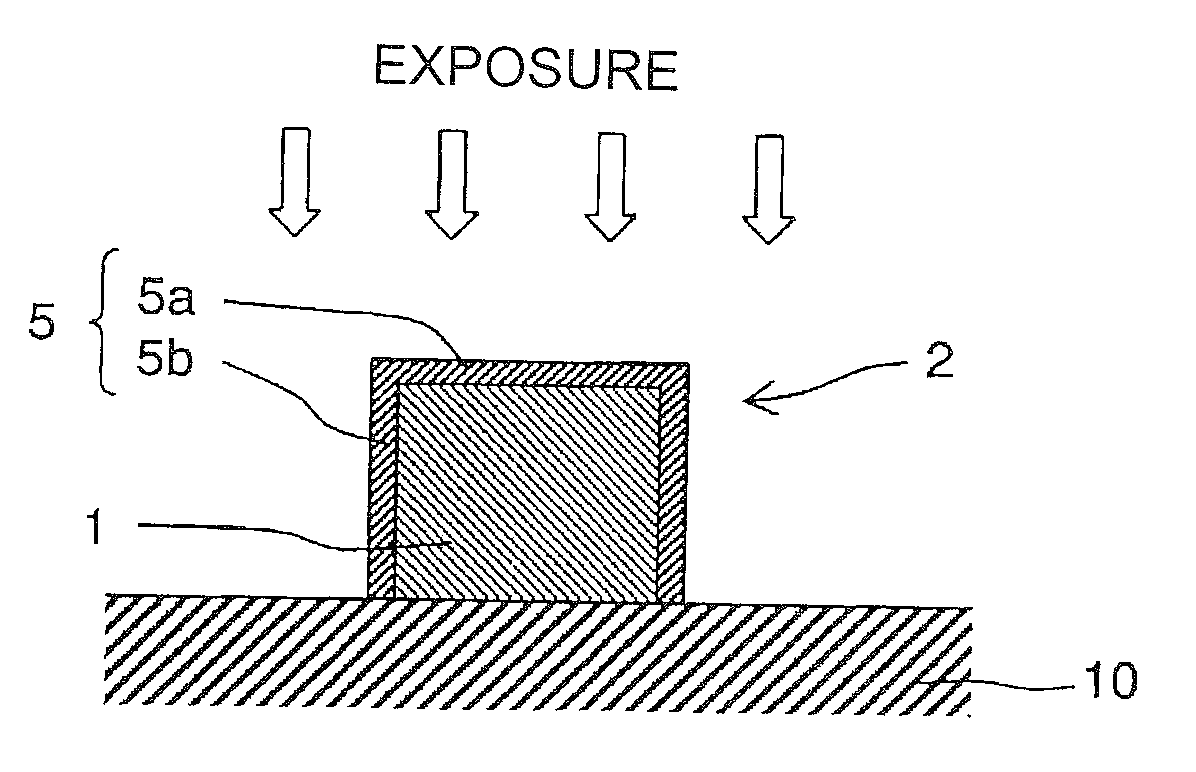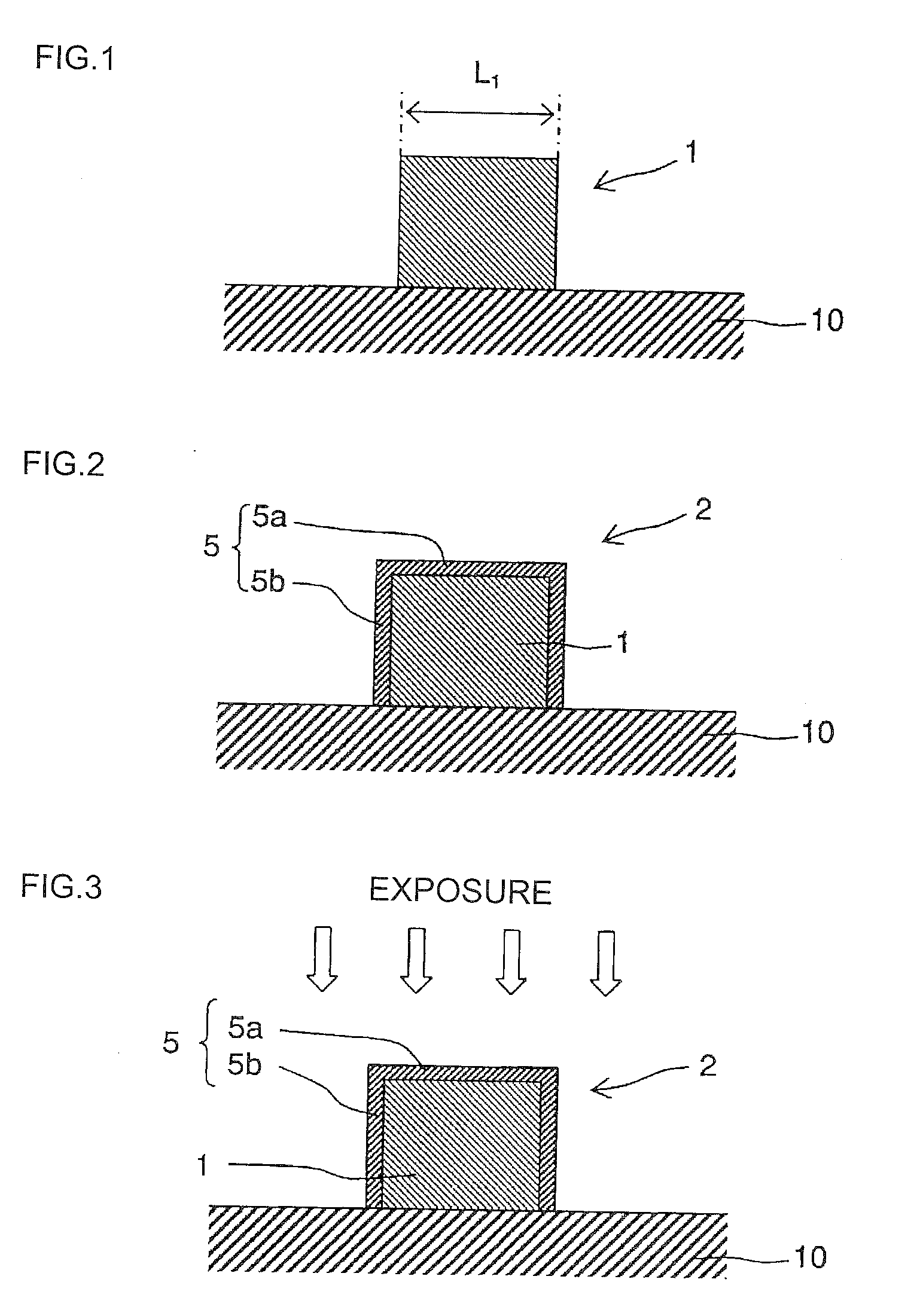Method for pattern formation and resin composition for use in the method
a resin composition and pattern technology, applied in the field of pattern formation and resin composition, can solve the problems of reducing the depth of focus, the microfabrication at a quarter micron level is said to be very difficult, and the exposure apparatus is expensive to reduce the wavelength of a light source, so as to achieve convenient and efficient formation, the effect of high application
- Summary
- Abstract
- Description
- Claims
- Application Information
AI Technical Summary
Benefits of technology
Problems solved by technology
Method used
Image
Examples
synthesis example 1
Polymer (A-1)
[0148]In 200 g of 2-butanone, 53.93 g (50 mol %) of a compound shown by the following formula (m-1), 10.69 g (10 mol %) of a compound shown by the following formula (m-2), and 35.38 g (40 mol %) of a compound shown by the following formula (m-3) were dissolved, and, 5.58 g of dimethyl-2,2′-azobis(2-methylpropionate) was added to prepare a monomer solution. A 1000 ml three-necked flask was charged with 100 g of 2-butanone, purged with nitrogen for 30 minutes, and heated to 80° C. with stirring. The above monomer solution was added dropwise to the flask using a dripping funnel over three hours. The polymerization reaction was carried out for six hours after initiation of dripping. After completion of polymerization, the polymer solution was cooled with water to 30° C. or less and added to 2000 g of methanol, and the precipitated white powder was collected by filtration. The white powder collected by filtration was washed twice with 400 g of methanol in a slurry state, fil...
synthesis examples 2 to 8
Polymers (A-2) to (A-8)
[0150]Polymers (A-2) to (A-8) having repeating units shown by the following formulas (A-2) to (A-8) were prepared in the same manner as in Synthetic Example 1, except for using different combinations of monomers.
[0151]Copolymerization ratio (molar ratio): a / b / c=50 / 37 / 13, Mw / Mn=1.62, Mw=5200, amount of remaining low-molecular weight components=0.03 mass %
[0152]Copolymerization ratio (molar ratio): a / b / c=47.3 / 15.8 / 36.9, Mw / Mn=1.60, Mw=5000, amount of remaining low-molecular weight components=0.05 mass %
[0153]Copolymerization ratio (molar ratio): a / b / c=53.6 / 9.8 / 36.6, Mw / Mn=69, Mw=8100, amount of remaining low-molecular weight components=0.04 mass %
[0154]Copolymerization ratio (molar ratio): a / b / c=40.4 / 15.5 / 45.1, Mw / Mn=1.73, Mw=6100, amount of remaining low-molecular weight components=0.08 mass %
[0155]Copolymerization ratio (molar ratio): a / b / c=50.0 / 36.9 / 13.1, Mw / Mn=1.78, Mw=8200, amount of remaining low-molecular weight components=0.03 mass %
[0156]Copolymerizatio...
synthesis example 9
Polymer (B-1)
[0168]As starting raw materials, 92 g of p-hydroxyphenylmethacrylanilide, 46 g of t-butoxystyrene, 13 g of hydroxybutylacrylate, and 12.8 g of azobisisobutyronitrile were dissolved in 600 g of isopropanol and reacted under reflux conditions (82° C.) for six hours to polymerize the monomers. After cooling the reaction vessel with flowing water, 150 g of isopropanol (IPA) was added and the mixture was poured into 4500 g of methanol while stirring. The resulting reprecipitate was filtered by suction. This reprecipitation procedure (from addition of IPA through suction filtration) was repeated four times and the resulting product was dried at 50° C. under vacuum. As a result, 121 g of a polymer (B-1) having a repeating unit shown by the following formula (B-1) with a molar ratio of p-hydroxyphenylmethacrylanilide / t-butoxystyrene / hydroxybutylacrylate=58 / 32 / 10, Mw of 5400, and Mw / Mn of 1.6 was obtained (yield: 81%).
PUM
 Login to View More
Login to View More Abstract
Description
Claims
Application Information
 Login to View More
Login to View More - R&D
- Intellectual Property
- Life Sciences
- Materials
- Tech Scout
- Unparalleled Data Quality
- Higher Quality Content
- 60% Fewer Hallucinations
Browse by: Latest US Patents, China's latest patents, Technical Efficacy Thesaurus, Application Domain, Technology Topic, Popular Technical Reports.
© 2025 PatSnap. All rights reserved.Legal|Privacy policy|Modern Slavery Act Transparency Statement|Sitemap|About US| Contact US: help@patsnap.com



